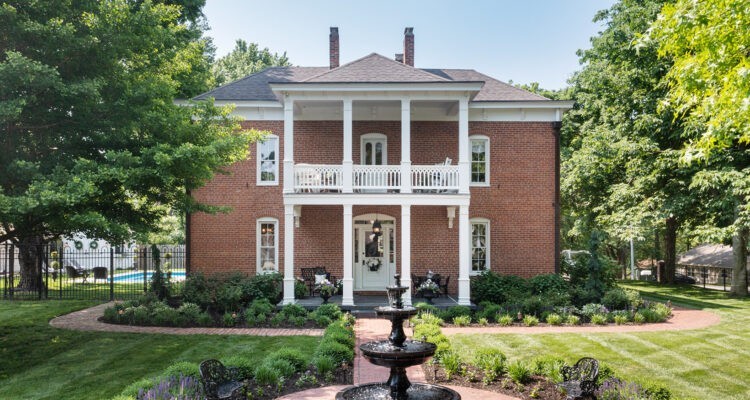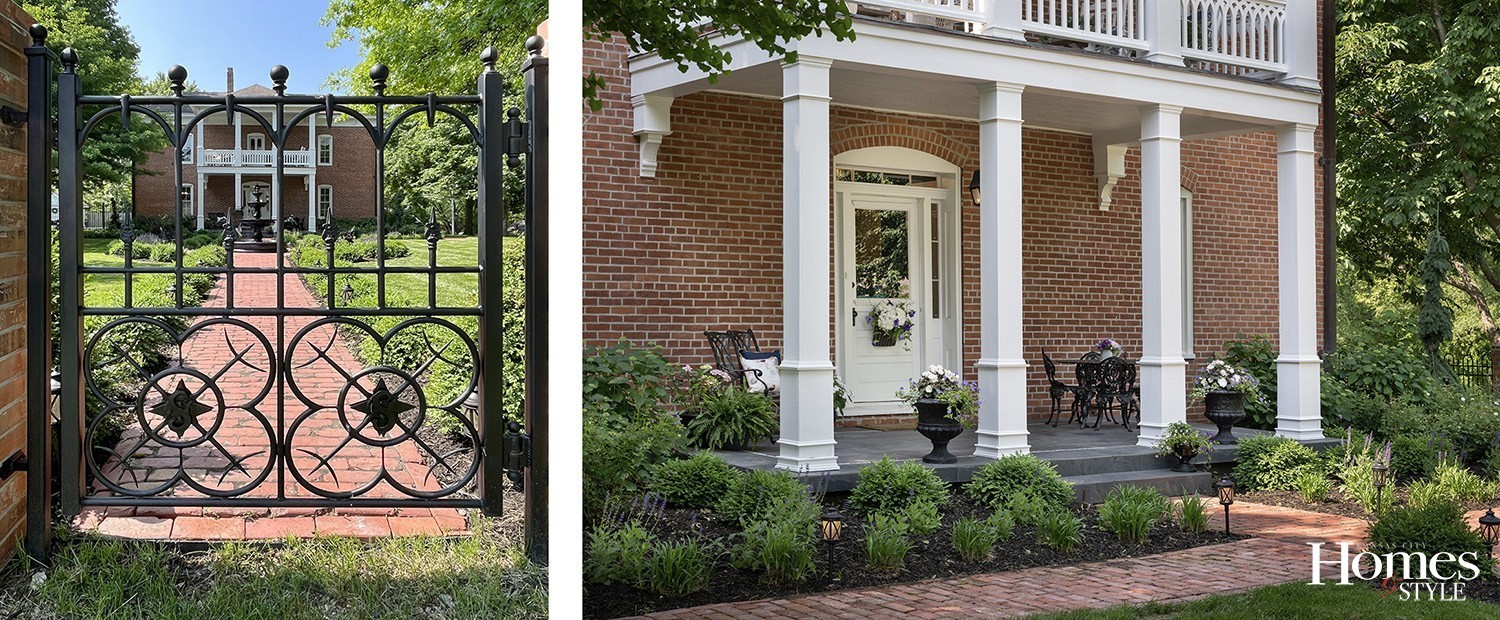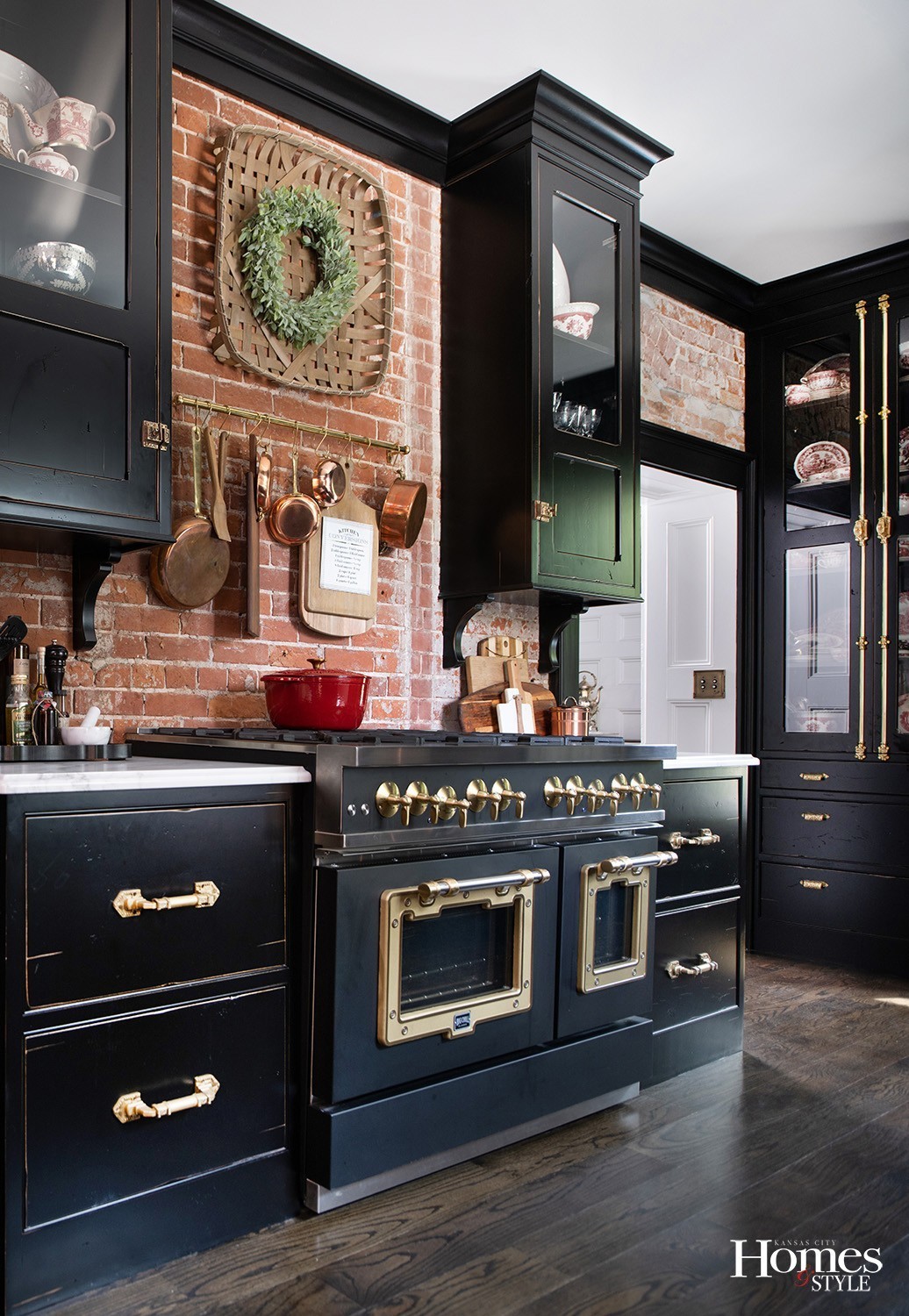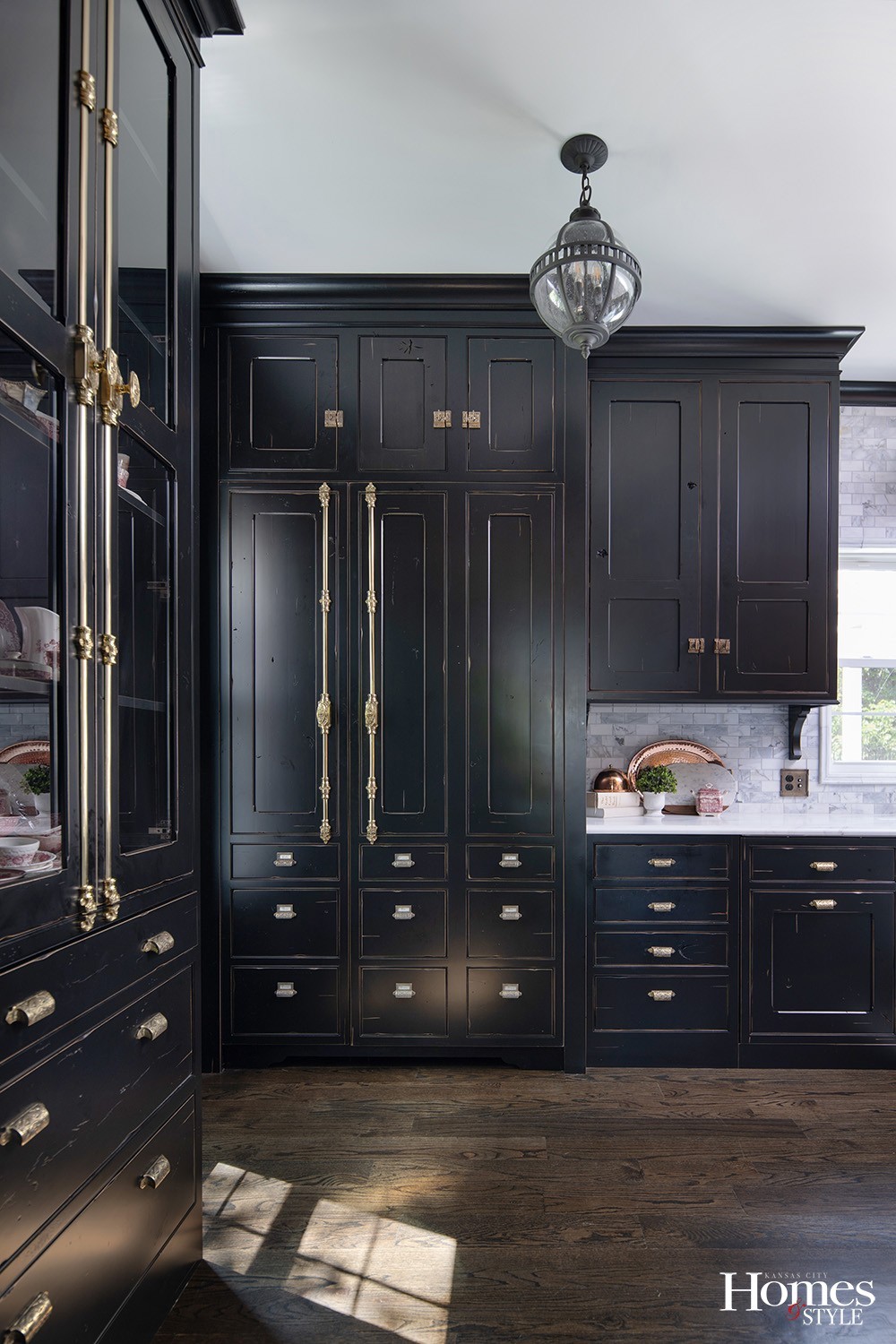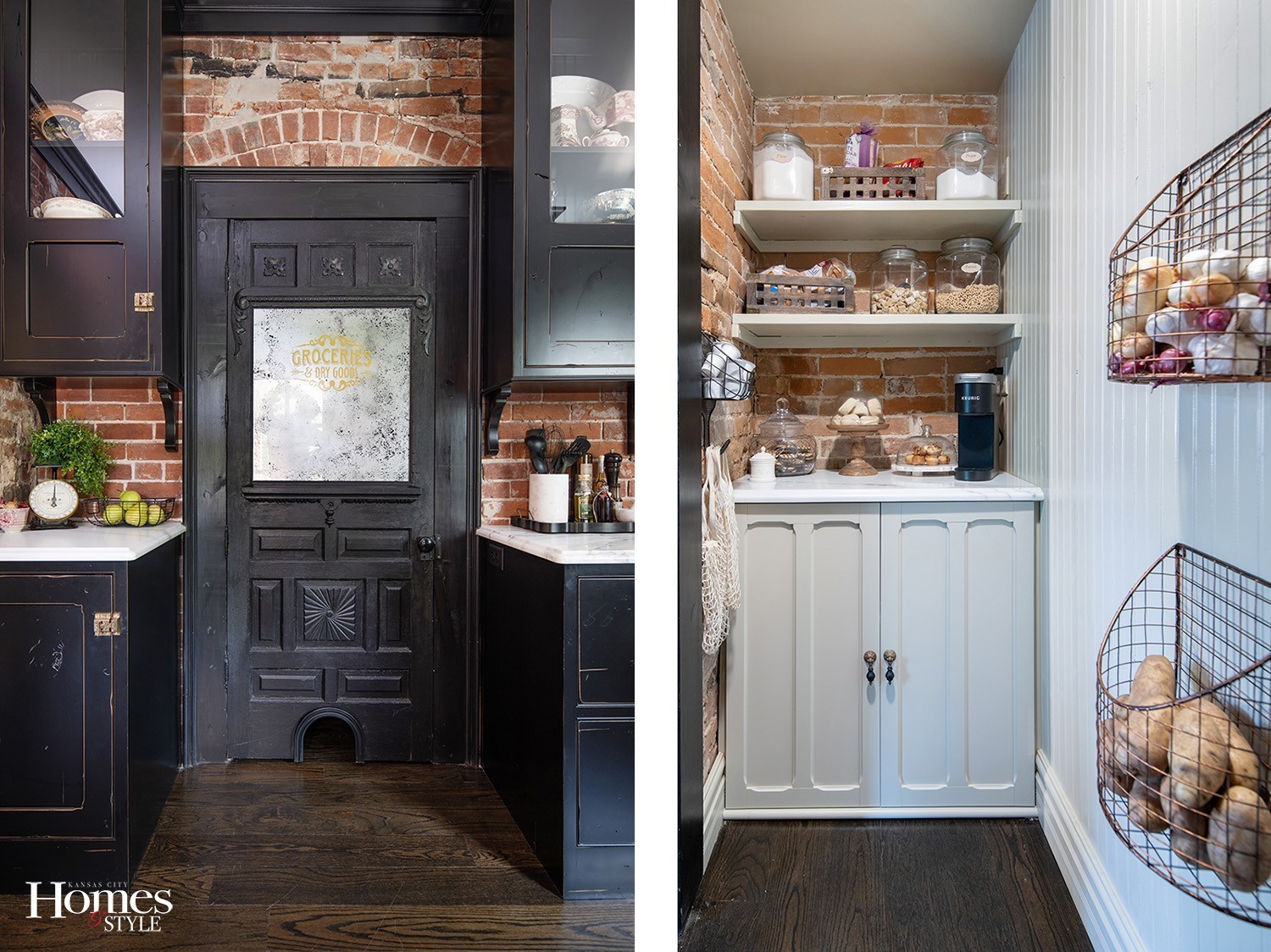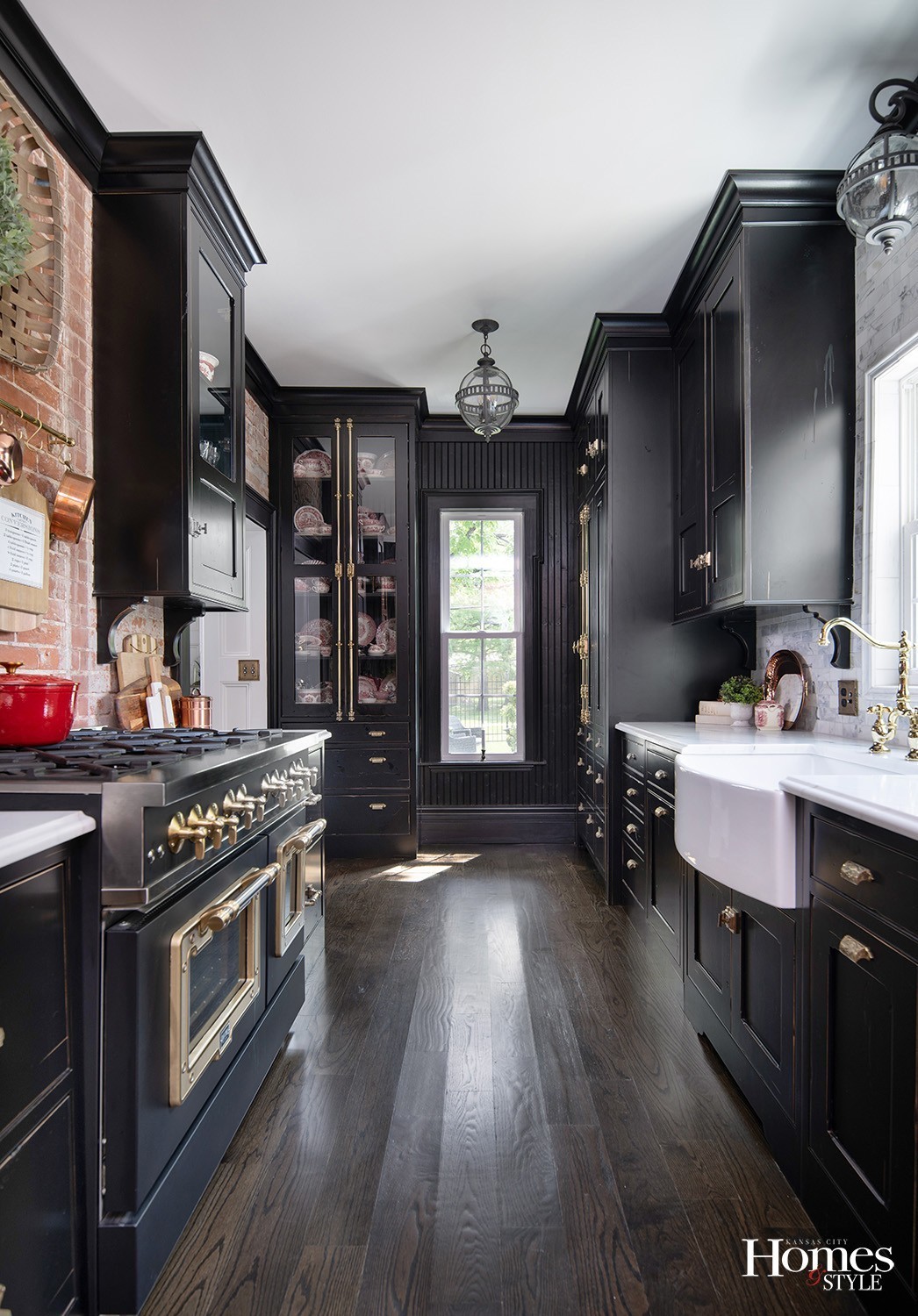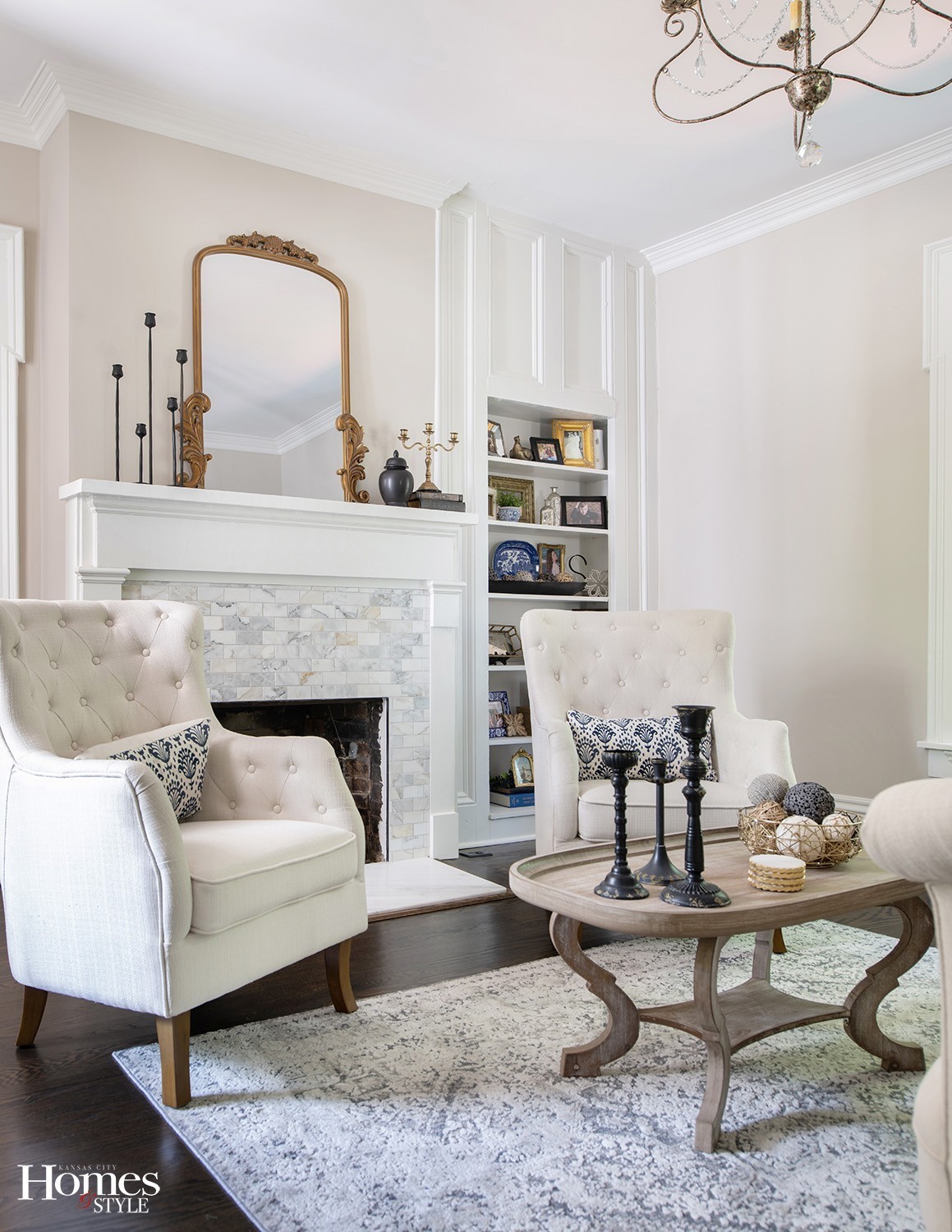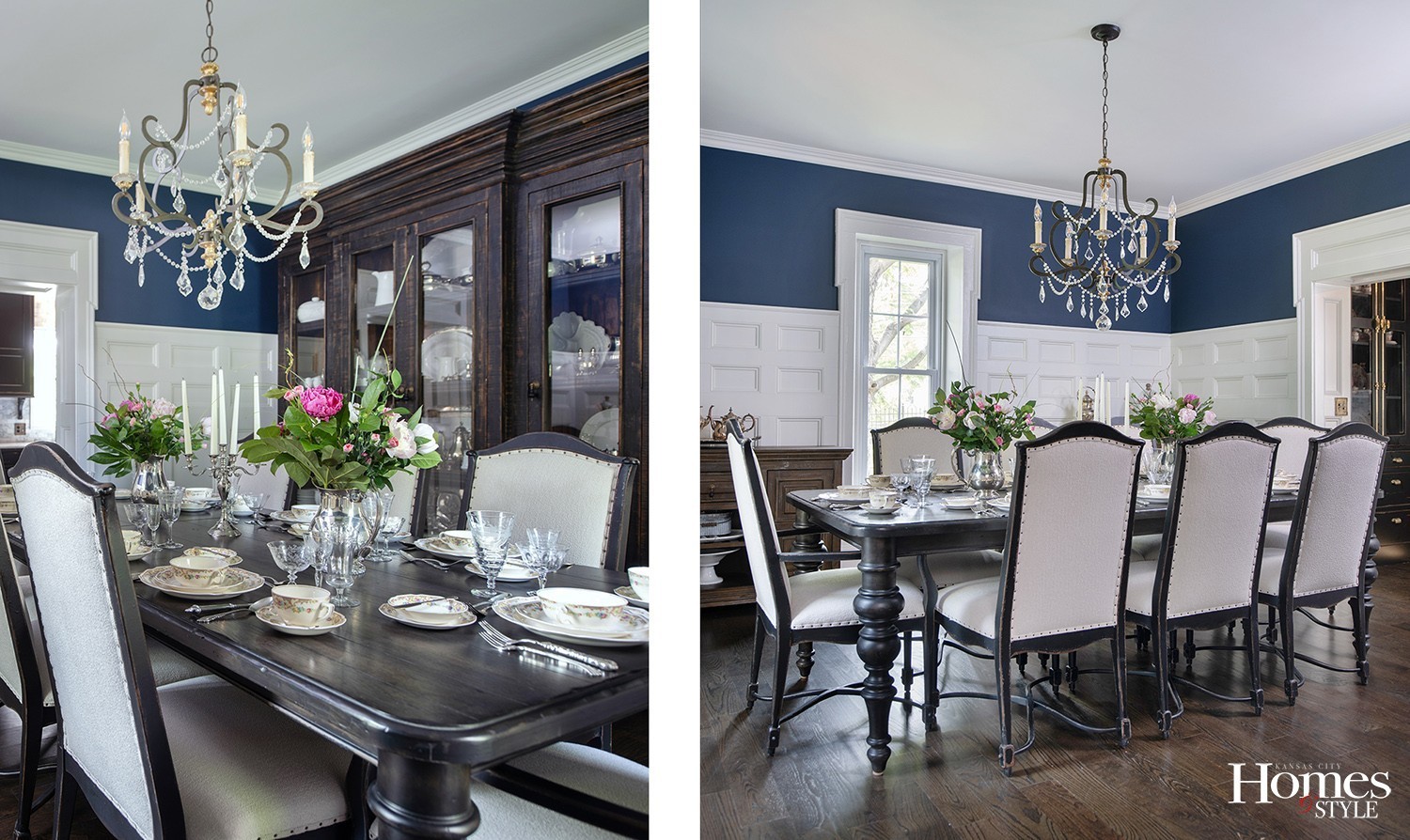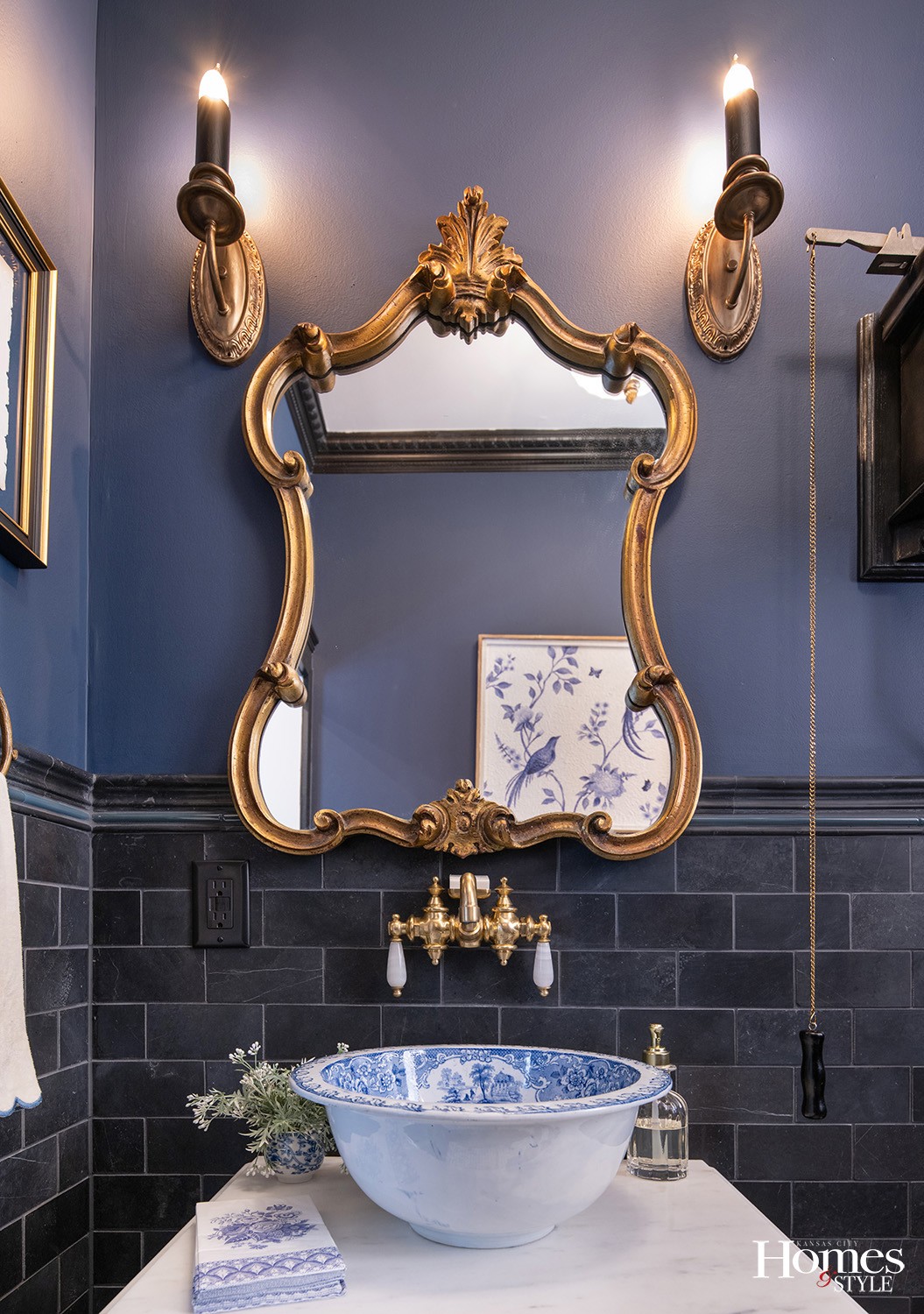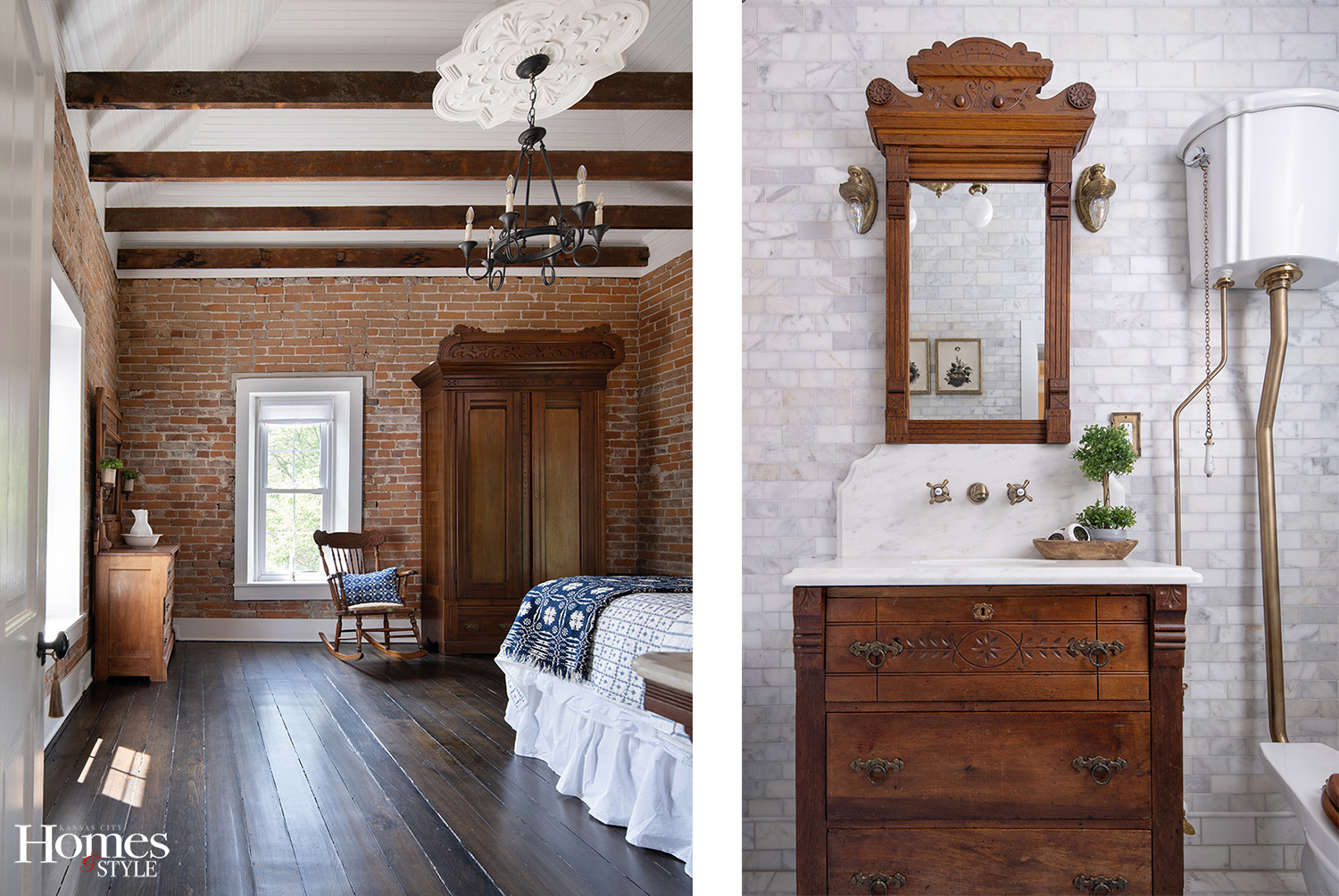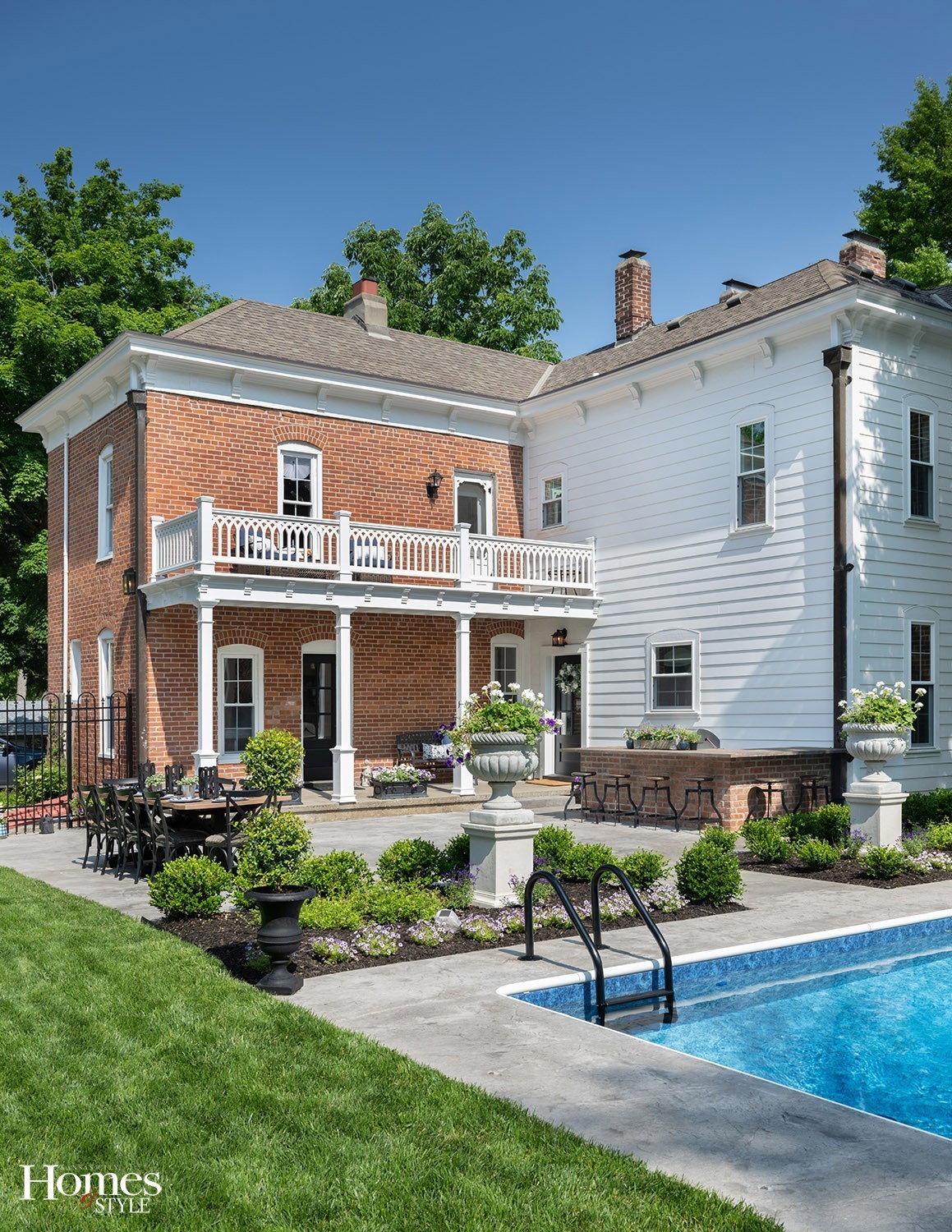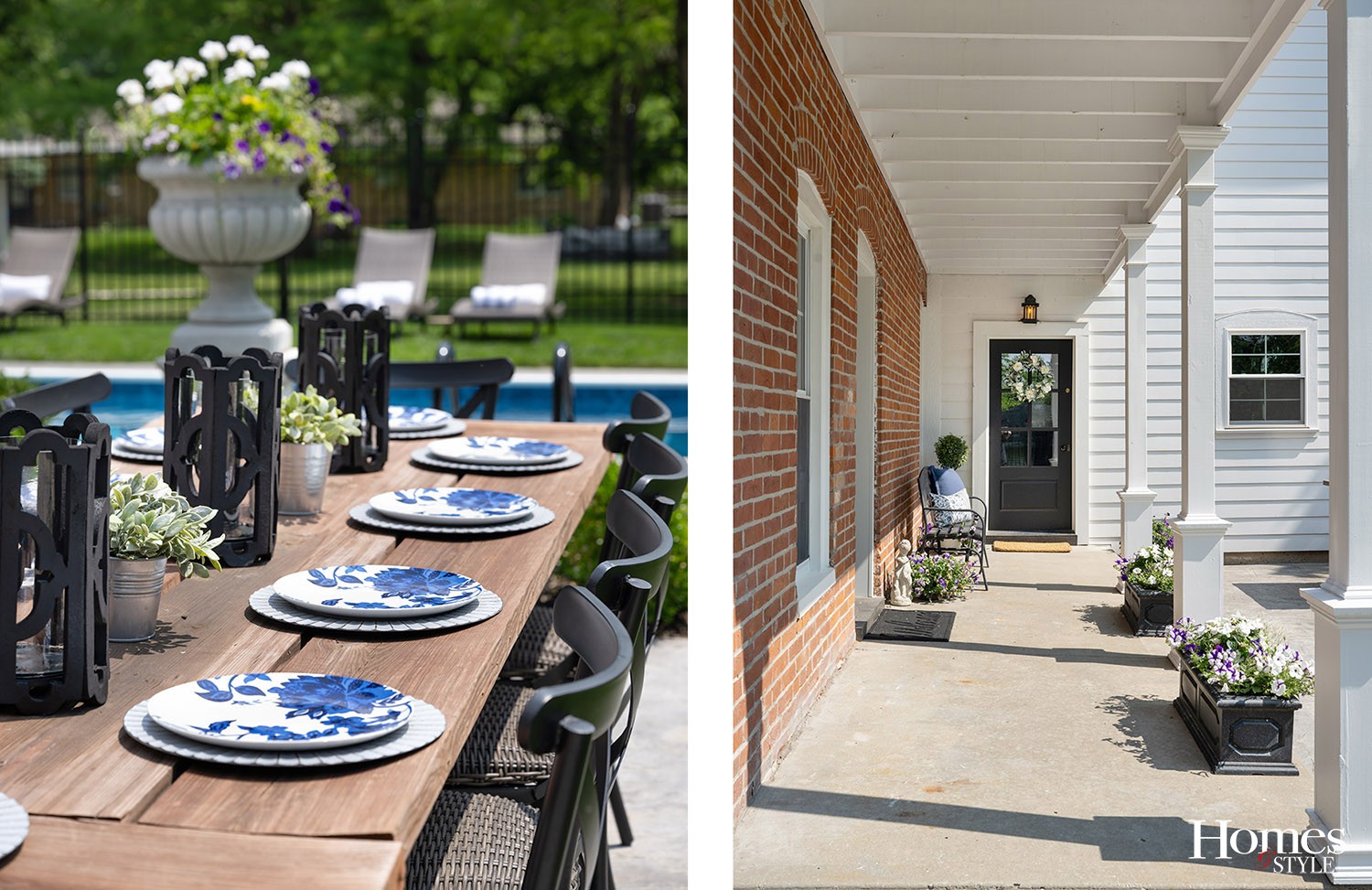Tour this Kansas City home where new additions help reveal an almost forgotten past.
Story by Michelle Mastro / Photography by Matt Kocourek
Old houses are having a moment. Historical homes of every style, from traditional farmhouses to mid century modern dream abodes, are filling up social feeds and seem to be front and center of every home renovation television show. But perhaps no one loves older homes better than Greg Springer and his wife, Natalie, owners of the Springer Building Company. Though their company routinely builds new houses, the pair purchased and have been restoring an 1855 house: dubbed the Saunders-Springer home. The endeavor has been lots of hard work but ultimately a labor of love.
Natalie and Greg are the home’s fifth owners. They purchased it in June 2019 and started renovations in August. “We basically everything’d it,” laughs Natalie. With four owners before, the home’s walls held an accumulation of pieces from different eras, like the 1980s ceiling fans—not historical to the home by any means. Hence, Natalie and Greg opted to remove these and so much more. They remedied the hardwood floors upstairs. Though original to the home, somewhere in the home’s long life the floors had been painted, leaving the couple the work of striping and refinishing the floors if they truly wanted the house to be as historically accurate as possible. In fact, everywhere Natalie and Greg turned, they saw much in the home that needed to be restored. While they appreciated the changes the prior owners had made to the home, Natalie and Greg wanted to return the home to its original glory.
History’s Mysteries
This is especially true in the home’s kitchen. When the couple bought the house, the small room held a rusted out cast-iron sink, only two lonely cabinets hanging on the walls, and an electric stove stubbornly taking up an entire wall. The adjacent breakfast room had two walls of windows that left no room for cabinets either. “So, we took everything down to the studs, making one space from the two small rooms,” says Natalie. Perhaps the only redeeming part of the kitchen was the exposed brick, which the pair worked to salvage. “I think it’s sad sometimes when people take an old house and tear out everything that gives it character just to put in new,” says Natalie. “It takes more time and money to save an old house, but it’s worth it.”
The process would be a long one. “Then Covid hit, so it became an even slower three years of renovating,” remembers Natalie. The dishwasher she ordered, for example, took two years to arrive. However, the silver lining in all the delays was that the extra time gave the couple the opportunity to reawaken the home’s buried history.
“We were given a notebook and documents on the house’s history by the prior owners’ daughter,” says Natalie. “The 4th owners, Mr. and Mrs. White, worked very hard researching it.” These prior owners were also antique collectors, and the house was full of period décor. “After the Whites died, their daughter lived here another 20 years and she is the one who actually sold us the house.”
One of the first pieces of history to come to light involved the kitchen. While a vital room in today’s homes, this particular kitchen wasn’t added to the house until 1928. And the source of those lovely original bricks? They were pieces of the home’s exterior making up the back of the house. There are approximately 60,000 of them in the house. Made from clay, the bricks had been dug from the property’s once 230 acres. They were then fired on the grounds. Now, they compose the interior and exterior’s three brick thick walls.
A House Spared
Sadly, Natalie also discovered the makers of the bricks had been enslaved peoples. To honor them, Natalie and Greg had the home’s new gate constructed with a depiction of a flower. “It was designed to honor each of the 5 owners with hidden initials for each and honor the enslaved people that fired all the bricks with a north star as the center of each Missouri dogwood flower on the gate.”
Realizing the original homeowners had owned slaves and were Southern sympathizers during the Civil War, Natalie was surprised to learn the home was still around at all. “The home was one of the few in the county to survive General Order Number 11, the order that called for all the lands of Southern sympathizers to be destroyed and their homes burned.”
It turns out, one of the many Jackson County skirmishes along the road out front during the Civil War saw an injured soldier of the Union Army fall on the house’s grounds. The home’s original owners brought him inside, nursed him back to health, and the soldier went on to rise in the ranks of the Union Army. By 1863, when Order No. 11 was issued, the original homeowners had to evacuate to Richmond but their home was spared. “When they returned after the war, they thought they were coming back to nothing. But the soldier they had saved protected the home, as he had risen through the ranks and remembered the family had helped him,” says Natalie.
But not all areas of the home or property yielded such unusual histories. The couple had decided to put in a pool on the back of the house. “And while digging, we were sure we’d find something, some artifact from the Civil War.” But all they found was a spoon from the 1960’s. “So it was kind of disappointing.”
Not-So-Heirloom Cabinetry
Even though they didn’t find much to go into the kitchen from the house or its grounds (besides perhaps the single spoon), Natalie and Greg elected to add in cabinetry that felt like it had always been there. These were going to do justice to the brick walls and the homes’ 168-year history, so the cabinets had to be just right.
They eventually chose reproduction cabinetry in the Eastlake style. The paint was added an heirloom finish, worn to make it look old. They also opted for no toekicks, antique style hardware and paneled appliances. That way, the new kitchen features would feel more historic.
To find the cabinets fitting her specifications, Natalie enlisted the help of cabinet designer, Mara Proctor, who had worked with her before. “Natalie has been a longtime customer, but this was the first time we worked together on a home meant for Natalie and Greg. And I was so proud and honored that she would trust me with that,” says Mara. “But it was all Natalie’s vision. She did a lot of research — she doesn’t give herself enough credit for all she has done to bring this house back to life, not one detail was overlooked.”
Just like she did when uncovering the home’s unique, hidden history, Natalie found the exact right cabinet hardware and finishes. “Natalie has got a really good eye at pulling things together,” says Mara. Every piece of the hardware carries an intricate detail. “She would send me inspiration photos,” explains Mara. “It took us a while to land on the exact right finish too.” According to Natalie, the feeling of working well together was mutual. “Mara was amazing,” she says. “She was so patient and took the challenge on and loved it. She nailed every detail. She had five sample doors done before we settled on the right finish.”
Histories of Homeowners
In the end, Natalie and Greg are just the latest in a short line of homeowners. After the original homeowners, the house was purchased in 1884, then again in 1918, and again in 1969 —until finally it changed hands one final time when Natalie and her husband bought the home.
Every time the home swapped owners, it took on new additions or renovations. The third owner modernized it, adding plumbing and electricity but also converting the house into three separate apartments. By 1969, the then new owners decided to convert the home back into a single-family home — “with bathrooms very much in the 1970s style,” says Natalie. “Think comfortable, but by no means historically accurate. I spent months researching period tile patterns and plumbing fixtures.”
It wasn’t until Natalie and Greg bought the abode that it would be fully restored to make the home feel its past. “During Covid, we did lots of road trips and visited 30 to 40 house tours to get inspiration of what the home should look like for it to feel more historically accurate,” Natalie says. “It was a lot of work, but it was worth it.”
The couple have certainly left their mark on this old house.
Resources
- Builder/Contractor: Springer Building Company LLC
- Interior Designer: Natalie Springer
- Kitchen Design, Cabinetry, Countertops: ckf
- Appliances: NFM
- Stove: Big Chill Company
- Flooring Hardwood: Exotic Floors LLC
- Painter: Pryor Painting Inc.
- Tile: Tile Innovations LLC
- Trim Work: Jr Millwork
- Landscaping / Landscape Lighting: Greco Lawn & Maintenance LLC
- Hardscaping: Handy Flatwork
- Fencing: H & A Fencing Company
- Bath Plumbing Fixtures: Signature Hardware, Vintage Tub & Bath
- Pull Chain Toilets: Renovators Supply

